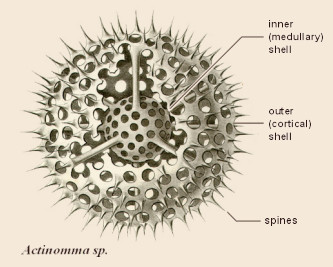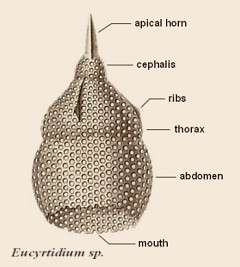Radiolaria are one of the most amazing groups
of the protozoa. They are marine, pelagic organisms.
They exhibit a complex endoskeleton, formed with silica, often radially
symmetrical and very beautiful. The endoskeleton (a central capsule)
covers a nucleated part of the cell and it separates this part from an ectoplasm.
You can find more info about radiolaria at http://www.radiolaria.org/.
The famous and beautiful drawings of Radiolaria
were made by Ernst Haeckel and published in a book Die Radiolarien (Berlin, 1862), available
online from the Kurt
Stüber's Online Library. Even more amazing resource is
a Report on the Radiolaria collected by Ernst Haeckel
during H.M.S. Challenger voyage 1873-1876.
Morphology of the Radiolaria skeletons:


Most of the presented specimens come from the following samples, courtesy of
Prof. Annika Sanfilippo and Mr. Warren Smith,
Scripps Institution of Oceanography, UCSD:
- Equatorial Pacific, 38-40 cm, Quaternary (JYN V 38P)
- Equatorial Pacific, 81-83 cm, Late Middle Eocene (DSDP 16-162-6-4)
- Equatorial Pacific, 100-102 cm, Early Pliocene (DSDP 9-77B-7-4)
- Equatorial Pacific, 65-67 cm, Pliocene/Late Miocene (DSDP 9-77B-10-2)
- Gulf of Mexico/Carribean, Middle Eocene (DSDP 15-149-34-CC)
- Gulf of Mexico/Carribean, 42-44cm, Early Oligocene (DSDP 10-94-12-4)
- Indian Ocean, 133-135cm, Quaternary (DSDP 24-238-2-6)
- Indian Ocean, 99-101cm, Pliocene/Late Miocene (DSDP 24-238-18-6)
and from the Eocene sediments from Barbados island (received from WARD's Natural Science supply house).
The images were processed using a
CombineZ v.4.2 program (by Alan Hadley) to increase a depth of field. Please note: I'm not 100% sure
if the presented genera are correctly identified. I will appreciate your comments very much.

Calocyclas |

Dictyoprora |

Eusyringium |

Heliodiscus |

Hexastylus |

Lithochytris |

Lophospyris |

Lychnocanoma |

Podocyrtis |

Thyrsocyrtis |

Xiphosphaera |

Xiphostylus |
|